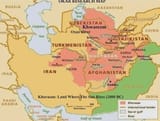Search Results
7/9/2025, 11:45:48 AM
>>509906864
>The Gnostic aeons are precisely divided, from bottom to top, into eight aeons (Ogdoad) just above our aeon (our world) and five superior aeons (Pentad, Quintet) and higher. This confirms the fact that not only did Manichaeism reach Tibet, but earlier Gnostic texts like the Pistis Sophia also reached it, if not in books, at least memorized by missionaries or refugees
>This is very likely, given that the 10th-century Muslim historian Al-Nadim wrote in his Encyclopedia that in China and the region called Khorasan, which corresponds to present-day Northeast Iran, Turkmenistan, Uzbekistan, Afghanistan, Tajikistan, and Kyrgyzstan, there were many followers of the Gnostic philosopher Bardesanes, a famous Gnostic who predated Mani.
>Above, a map of Khorasan according to ancient accounts, with the current borders of the countries. According to the Bon Scriptures and the Bon scholars cited above, highlighted in red, the doctrine of Tonpa Shenrab originated precisely in the countries that comprised ancient Khorasan! These are the eastern satrapies (provinces) of the Sassanid Persian Empire, and beyond them, it includes China and the Uyghur country! What religion was present throughout this Khorasan region before the 8th century and is similar to Buddhism?
>It can't be Nestorian Christianity, as it bears no resemblance. It can't be Mithraism, because, in addition to the differences, it had already disappeared, replaced by Zoroastrianism, absorbed by Manichaeism, and transformed into Buddhist sects of Manichaean origin. It can't be Islam, because it is completely different and hadn't yet established itself in this region. It can't be Shamanism, because it is too simple and different. Finally, it can't be Zoroastrianism, not even its version called Zurvanism, because it is different
>The Gnostic aeons are precisely divided, from bottom to top, into eight aeons (Ogdoad) just above our aeon (our world) and five superior aeons (Pentad, Quintet) and higher. This confirms the fact that not only did Manichaeism reach Tibet, but earlier Gnostic texts like the Pistis Sophia also reached it, if not in books, at least memorized by missionaries or refugees
>This is very likely, given that the 10th-century Muslim historian Al-Nadim wrote in his Encyclopedia that in China and the region called Khorasan, which corresponds to present-day Northeast Iran, Turkmenistan, Uzbekistan, Afghanistan, Tajikistan, and Kyrgyzstan, there were many followers of the Gnostic philosopher Bardesanes, a famous Gnostic who predated Mani.
>Above, a map of Khorasan according to ancient accounts, with the current borders of the countries. According to the Bon Scriptures and the Bon scholars cited above, highlighted in red, the doctrine of Tonpa Shenrab originated precisely in the countries that comprised ancient Khorasan! These are the eastern satrapies (provinces) of the Sassanid Persian Empire, and beyond them, it includes China and the Uyghur country! What religion was present throughout this Khorasan region before the 8th century and is similar to Buddhism?
>It can't be Nestorian Christianity, as it bears no resemblance. It can't be Mithraism, because, in addition to the differences, it had already disappeared, replaced by Zoroastrianism, absorbed by Manichaeism, and transformed into Buddhist sects of Manichaean origin. It can't be Islam, because it is completely different and hadn't yet established itself in this region. It can't be Shamanism, because it is too simple and different. Finally, it can't be Zoroastrianism, not even its version called Zurvanism, because it is different
Page 1
